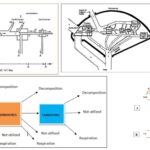IGCSE Biology 40 Views 1 Answers
Sourav PanLv 9November 15, 2024
Describe a food chain as showing the transfer of energy from one organism to the next, beginning with a producer
Describe a food chain as showing the transfer of energy from one organism to the next, beginning with a producer
Please login to save the post
Please login to submit an answer.
Sourav PanLv 9May 15, 2025
A food chain is a linear sequence that illustrates how energy and nutrients flow through an ecosystem, starting with producers and moving through various levels of consumers. Each step in this chain represents a transfer of energy from one organism to another.
Example of a Simple Food Chain
Let’s consider a straightforward food chain in a terrestrial ecosystem:
- Producer: Grass
- Role: Grass is a primary producer that captures solar energy through photosynthesis. It converts sunlight into chemical energy stored in the form of glucose.
- Energy Source: Solar energy.
- Primary Consumer: Grasshopper
- Role: The grasshopper is a herbivore that feeds on grass, consuming the chemical energy stored in the plant.
- Energy Transfer: When the grasshopper eats the grass, it obtains approximately 10% of the energy stored in the grass, as some energy is lost as heat and used for metabolic processes.
- Secondary Consumer: Frog
- Role: The frog is a carnivore that preys on grasshoppers. It gains energy by consuming the grasshopper, which contains the energy originally captured from the grass.
- Energy Transfer: The frog receives about 10% of the energy that was available to the grasshopper, continuing the flow of energy through the food chain.
- Tertiary Consumer: Snake
- Role: The snake is a higher-level carnivore that feeds on frogs. It obtains energy by consuming animals lower in the food chain.
- Energy Transfer: The snake absorbs roughly 10% of the energy stored in the frog, further illustrating how energy diminishes at each trophic level.
- Quaternary Consumer (Optional): Eagle
- Role: An eagle can be considered a quaternary consumer if it preys on snakes. It represents another level of energy transfer.
- Energy Transfer: Similar to previous levels, the eagle would receive about 10% of the energy contained in the snake.
Summary of Energy Flow
- Energy Loss: At each step in this food chain, approximately 90% of the energy is lost due to metabolic processes (e.g., respiration, movement) and as heat. This means that only about 10% of the energy from one trophic level is available to the next.
- Ecological Impact: Food chains illustrate not only how energy flows through an ecosystem but also highlight the interconnectedness of organisms and their dependence on one another for survival.
0
0 likes
- Share on Facebook
- Share on Twitter
- Share on LinkedIn
0 found this helpful out of 0 votes
Helpful: 0%
Helpful: 0%
Was this page helpful?




